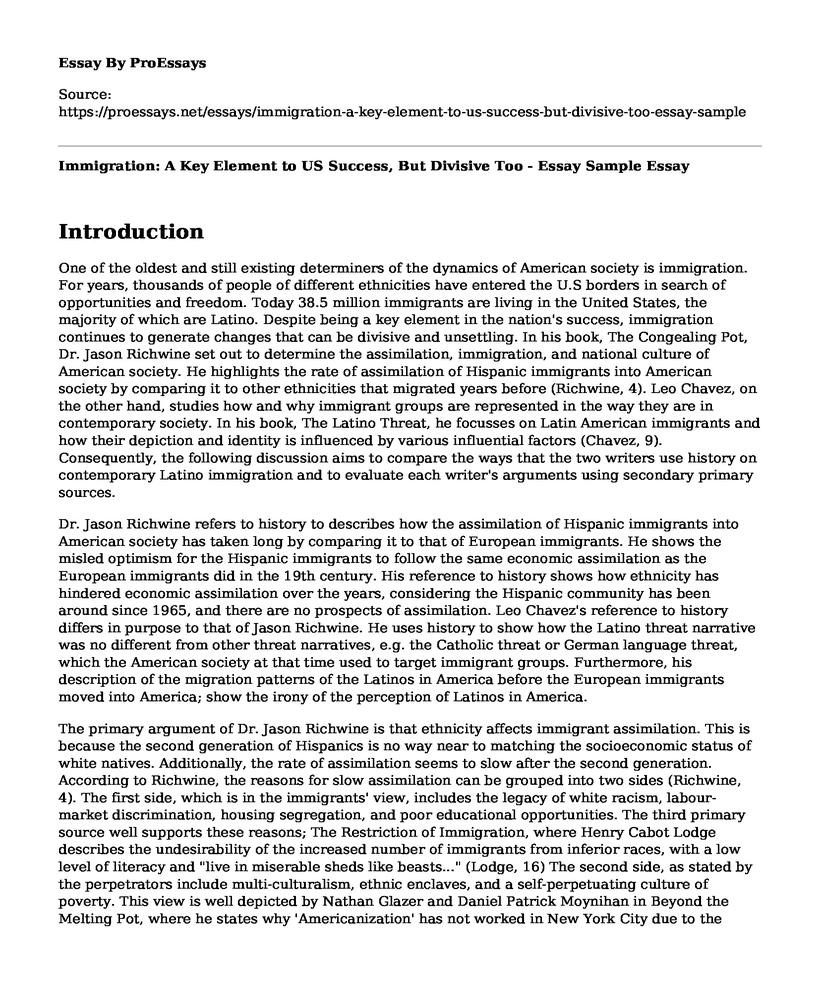Introduction
One of the oldest and still existing determiners of the dynamics of American society is immigration. For years, thousands of people of different ethnicities have entered the U.S borders in search of opportunities and freedom. Today 38.5 million immigrants are living in the United States, the majority of which are Latino. Despite being a key element in the nation's success, immigration continues to generate changes that can be divisive and unsettling. In his book, The Congealing Pot, Dr. Jason Richwine set out to determine the assimilation, immigration, and national culture of American society. He highlights the rate of assimilation of Hispanic immigrants into American society by comparing it to other ethnicities that migrated years before (Richwine, 4). Leo Chavez, on the other hand, studies how and why immigrant groups are represented in the way they are in contemporary society. In his book, The Latino Threat, he focusses on Latin American immigrants and how their depiction and identity is influenced by various influential factors (Chavez, 9). Consequently, the following discussion aims to compare the ways that the two writers use history on contemporary Latino immigration and to evaluate each writer's arguments using secondary primary sources.
Dr. Jason Richwine refers to history to describes how the assimilation of Hispanic immigrants into American society has taken long by comparing it to that of European immigrants. He shows the misled optimism for the Hispanic immigrants to follow the same economic assimilation as the European immigrants did in the 19th century. His reference to history shows how ethnicity has hindered economic assimilation over the years, considering the Hispanic community has been around since 1965, and there are no prospects of assimilation. Leo Chavez's reference to history differs in purpose to that of Jason Richwine. He uses history to show how the Latino threat narrative was no different from other threat narratives, e.g. the Catholic threat or German language threat, which the American society at that time used to target immigrant groups. Furthermore, his description of the migration patterns of the Latinos in America before the European immigrants moved into America; show the irony of the perception of Latinos in America.
The primary argument of Dr. Jason Richwine is that ethnicity affects immigrant assimilation. This is because the second generation of Hispanics is no way near to matching the socioeconomic status of white natives. Additionally, the rate of assimilation seems to slow after the second generation. According to Richwine, the reasons for slow assimilation can be grouped into two sides (Richwine, 4). The first side, which is in the immigrants' view, includes the legacy of white racism, labour-market discrimination, housing segregation, and poor educational opportunities. The third primary source well supports these reasons; The Restriction of Immigration, where Henry Cabot Lodge describes the undesirability of the increased number of immigrants from inferior races, with a low level of literacy and "live in miserable sheds like beasts..." (Lodge, 16) The second side, as stated by the perpetrators include multi-culturalism, ethnic enclaves, and a self-perpetuating culture of poverty. This view is well depicted by Nathan Glazer and Daniel Patrick Moynihan in Beyond the Melting Pot, where he states why 'Americanization' has not worked in New York City due to the recreation of ethnic identities (Glazer and Daniel, 44).
In his book The Latino Threat, Chavez shows how their historical, social identity greatly hinders the assimilation of Latinos into American society as being threats to the community. According to Chavez, Latinos are viewed to be invaders from the south who migrate to take back their land and disrupt the American way of life (Chavez, 9). By using the examples of the German language threat, his argument was supported by California Senate sentiments to Congress in 1878, which showed the incapability of the Chinese people to adapt to the American institutions due to their ways of life that were perceived to erode the American way of life (Shuen, 13).
Conclusion
In conclusion, immigrant assimilation in the United States is affected by many factors. The main factor in today's society is ethnic identities shaped by stereotypical ideas about people of a particular origin. Furthermore, these ideas keep changing from one generation to the other making it hard for assimilation to take root. Jason Richwine and Leo Chavez both show how ethnicity is used against immigrant assimilation, citing historical events that have led to the present state of American society.
Works Cited
Chavez, Leo. The Latino threat: Constructing immigrants, citizens, and the nation. Stanford University Press, 2013. Retrieved from: https://bit.ly/2xj7gkM
Glazer, Nathan, and Daniel Patrick Moynihan. Beyond the Melting Pot: The Negroes, Puerto Ricans, Jews, Italians, and Irish of New York City. Vol. 63. Cambridge, MA: MiT Press, 1970. Retrieved from: https://bit.ly/2QDxxRH
Lodge, Henry Cabot. "The restriction of immigration." The North American Review 152.410 (1891): 27-36. Retrieved from: https://www.jstor.org/stable/25102112?seq=1#metadata_info_tab_contents
Richwine, Jason. "The congealing pot: Today" s immigrants are different from waves past." National Review 33 (2009): 17-18. Retried from: https://link.springer.com/chapter/10.1057/9781137349897_5
Shuen, Rachel G. ""The Abomination of Mankind": Anti-Chinese Sentiment and the Borders of Belonging in San Francisco's Chinatown." (2012). Retrieved from: https://repository.wellesley.edu/thesiscollection/70/
Cite this page
Immigration: A Key Element to US Success, But Divisive Too - Essay Sample. (2023, Apr 28). Retrieved from https://proessays.net/essays/immigration-a-key-element-to-us-success-but-divisive-too-essay-sample
If you are the original author of this essay and no longer wish to have it published on the ProEssays website, please click below to request its removal:
- Research Paper on Refugees Issue
- Feminist Praxis Essay Example
- Essay Sample on Drugs and Human Behaviors
- The Trial of the Brett Kavanaugh vs. Christine Ford - Essay Sample
- Essay Sample on Illegal Substance Use: Recreational and Medical Abuse
- Essay on Commercial Media as Storyteller: Violence in Movies & Learning From Stories
- Paper Example on Uprooting White Supremacy Culture: Ensuring Racial Equity in Schools







